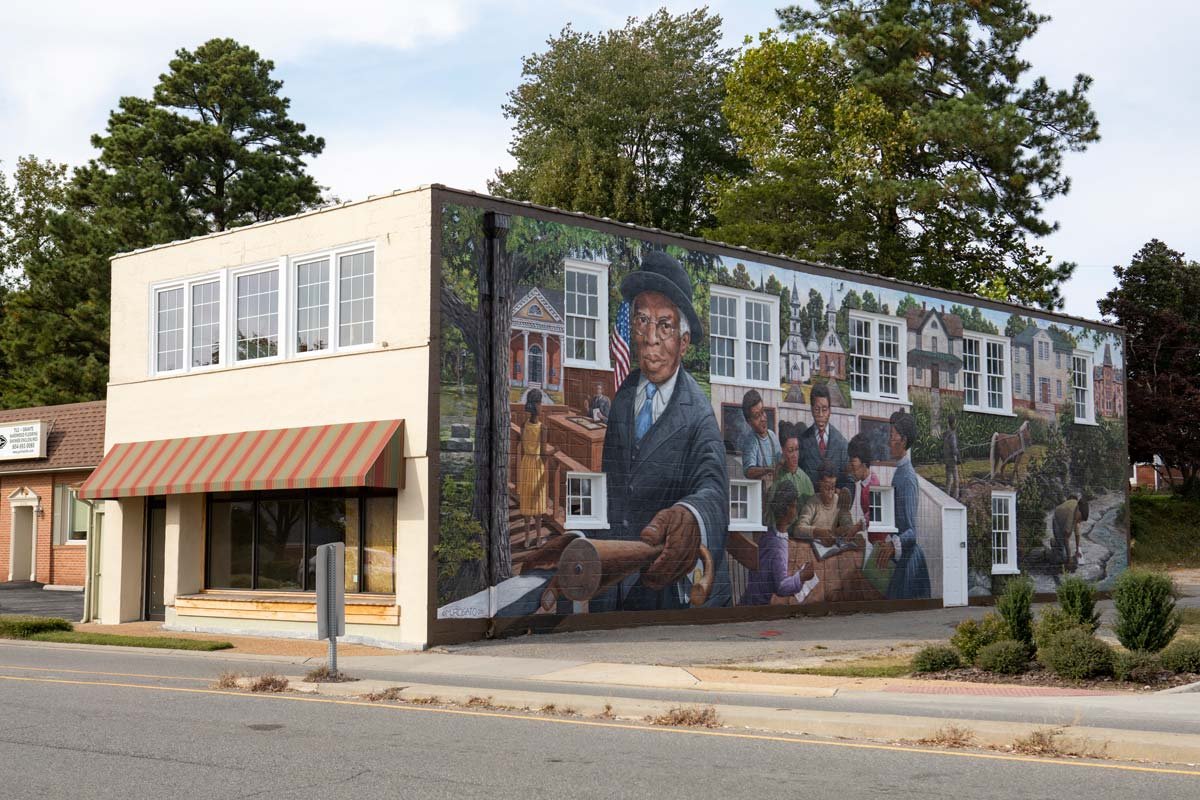
The Life & Legacy of T.C. Walker
Known as Virginia’s “Black Governor,” Thomas Calhoun (T.C.) Walker was a teacher, lawyer, and government official.
Born a slave less than a year before President Lincoln signed the Emancipation Proclamation, Walker grew up to become the first African American to practice law in Gloucester County.
In 1891, he was elected to the Gloucester County Board of Supervisors and in 1934 President Roosevelt appointed Walker as the advisor and consultant of Negro affairs for the Virginia Emergency Relief Administration.
About The Mural
-
The honey-pod tree, which once stood near Gloucester Court House in the middle of Main Street, shaded the slave block where many of Walker's own relatives had been sold. Walker’s autobiography, published in 1958, was titled “The Honey-Pod Tree: The Life Story of Thomas Calhoun Walker.” While Walker would live to see both the tree and the slave block destroyed, he went on to live through what he called “honey-pod tree moments,” or times in life that were unfair, that would set you back, that you had to overcome. In life there are always honey-pod trees and he never wanted to forget that. It is in the fighting to overcome, in the work to move beyond, that you can truly tear down all the honey-pod trees and achieve your goals.
-
History shows us that as a lawyer, Walker was motivated to defend injustices to African Americans. It was in this moment that Walker was motivated to pursue justice. In this scene, Walker had graduated from Hampton Institute and was back in Gloucester helping his father build a house and farm. One day, while walking downtown, he ventured inside the courthouse as 14-year-old Mary Manly was tried for housebreaking (burglary). Because she had no legal representation, it became her word against her accusers. The judge found her guilty and sentenced her to two years in prison. Walker then and there decided to go to law school, determined to never let something like that happen again.
-
It was not enough for Walker himself to get an education and make a difference in his own life.He wanted that for everyone. Walker was known to spend time on Main Street, cane in hand, tapping and pointing at folks. Get busy, he would say. Don’t let anything stop you. Persevere. Have faith. Get an education. Your life is in your hands…and will be what you make of it.
-
Known as the pastor of pastors, Walker organized and conducted religious teaching sessions to enable the people of Gloucester County as well as surrounding areas and beyond to have a better understanding of the Bible. His faith formed his code of ethics and guided all the work he did in his life. In the mural, there are several churches which are representative of the faith communities where he served. His family church, Bethel Baptist, is among those pictured. Bethel birthed five daughter churches; four in Gloucester and one in Williamsburg. Bethel's cemetery serves as Mr. Walker's resting place.
-
While Walker had children of his own, he also took in and raised others. Illustrated here is an imagined moment of Walker with children around a table, showcasing his belief that with the love of family, and an education, there is no stopping you. Education and supporting children was so important that Walker also helped build the county’s first high school for black students and personally convinced philanthropist Julius Rosenwald, CEO of Sears, Roebuck & Co., to build six schools in the county for black children. Rosenwald funded 5,300 elementary and training schools in partnership with local communities and in 1919 Walker travelled to Chicago to meet with Rosenwald and secure funding for six schools and a teacher’s home. About 800 of these Rosenwald schools remain nationwide, including one in Gloucester – the Woodville School.
-
The importance of property ownership and education were among the two strongest pieces of advice Walker gave and fought for. He owned and lived in a house on Gloucester Main Street, which remains there today, owned by Hampton University. Walker is also remembered for helping the county earn the highest rate of black home ownership in the country by 1930.
-
Growing up, Walker’s mother and grandmother often feared that they would not have enough food to help them survive through the winter. After completing his studies at Hampton Institute, Walker returned to Gloucester and helped show people how to more effectively grow their own food. You don’t need to just be able to survive the winter, but everyone should be able to provide for themselves. Being able to cultivate and provide for yourself, being dedicated to getting an education and working toward owning your own property were hallmarks of his mentorship and guidance.
-
The Gloucester Training School became the first public high school for black students in Gloucester County. In 1921, Walker and others constructed a wooden building for the school with gifts from the Rosenwald Fund and other national and local donors. The original building was replaced with a brick structure in 1951. With the integration of schools and subsequent reorganizations, the present school functioned as Gloucester Intermediate School in the late 1960s, Gloucester Middle School in the mid-1970s and from 1986 to 2012 was the Thomas Calhoun Walker Elementary School.
TC Walker Mural Story
-
When Walker was 13, his father told him he was too old to learn. A Sunday school teacher would go on to give him a spelling book so he could learn to read and write on his own. But it was this moment, as shown in this scene, where Walker realized he could still learn new things. One day, while in the post office, a doctor came in to check his mail. He opened an envelope, pulled out the letter and dropped the envelope to the ground. Walker picked up the envelope and saw writing he had never seen before – cursive instead of block letters. He took the envelope down to the creek and practiced writing the letters he saw on the envelope over and over again in the sand until he could decipher what the cursive letters were. “Dr. Tabb” was what he wrote, and in this transitional and monumental moment of his life, Walker realized he could in fact still learn.
-
With $2.25, saved penny by penny for months by Walker and his mother, Walker made his way from Gloucester to Hampton Institute, now Hampton University, in search of a higher education. By the time he arrived, he only had 92 cents left. While denied admission because he could not pass the entrance exam, Walker persuaded the school to make an exception. In exchange for working on campus during the day, Walker attended classes at night. Among Walker’s first teachers was Booker T. Washington. In recognition of his education, Walker donated his home on Gloucester's Main Street upon his death.
The Incredible Life & Lasting Impact of TC Walker
Explore the incredible life and lasting impact T.C. Walker, known as “Lawyer Walker,” had not just on the Gloucester community, but the entire nation. His life and legacy is celebrated in a mural on Gloucester Main Street and in this mini-documentary, commissioned by The Cook Foundation
Explanation of the T.C. Walker Mural by Artist Michael Rosato
“It’s the life story of T.C. Walker and starts when he was a boy, a child, until he reaches his later years. It’s a remarkable story. My goal with the mural is to get you to really know, on a more in-depth level, all the things that made T.C. Walker, T.C. Walker.” – Artist Michael Rosato









